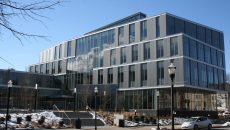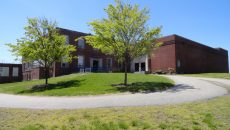Coburn Hall on South Campus. (Katrina Desrosiers/Connector)
Katrina Desrosiers
Connector Contributor
No elevator, no ramp, bathrooms in the basement, limited parking and inaccessible offices make Coburn Hall out of reach for some UMass Lowell students, faculty and staff. In order for Coburn Hall to be an appropriate fit for South Campus, many students say that renovations are necessary to enhance classrooms and overall design of the building.
Junior English major and disability studies minor Lily Finn questioned the reason for Coburn’s purpose as an academic building. “I just don’t think that there should be classes in Coburn. Honestly, if not everyone can go in it… it just doesn’t make sense; why have a building that not everyone can get to?” she said.
According to administration officials, the university will address these issues in a full-scale renovation of the building by 2020.
“There is not a single square foot of the building that is accessible right now if you have a mobility challenge, and the only real toilet rooms are in the basement. I would say for a four story building that’s a problem. Fortunately, we’ll be addressing that,” said Director of Campus Planning and Development Adam Baacke.
Coburn Hall is the oldest academic building on campus and was originally designed as the State Teachers College in Lowell, Baacke said. The building had a gymnasium, science laboratories, a drawing room and a lunch room in addition to classrooms.
“Obviously, as the university has grown and expanded, its role has changed, but it remains in many ways our ‘old main’ building,” he said. “We view it as a signature building on campus, and it’s really exciting that the chancellor has decided that this is one of the high priority projects to move forward with.”
Baacke said there are four major qualities that a building needs to be accessible: accessible parking within 200 feet, an accessible route from parking into the building, accessible entrances into the building and accessible bathrooms. Some campus buildings, like Coburn Hall on South Campus and Perry Hall on North Campus, were constructed before the Americans with Disabilities Act was passed, and he said that this is why they do not have full compliance and are not up to the current accessibility standards.
“Unfortunately, as recently as 2011, a quarter to a third of buildings on campus met that standard, which meant two thirds to three quarters did not. We’ve now gotten to a place where we’re somewhere around 75 percent of buildings on campus meet that standard,” he said. By 2020, the University’s goal is to have 90 percent of buildings accessible for all students.
When Coburn Hall is completely renovated, the total investment will be about $50 million, said Baacke. The renovation will include an elevator, new restrooms, ramps into the building, updated classrooms and more.
“The minimum project we could have done there was still probably a 15 to 20 million dollar project. As a result we said, ‘let’s really do this right,’ and fortunately the chancellor has strongly endorsed that,” he said.
The Coburn Hall Project is essential for those with disabilities who need to access the building; Finn said that students with a mobility impairment are not able to safely get into Coburn Hall, and therefore are not able to schedule office hours with professors from the Department of World Languages and Cultures. Jessica Carnevale, a first-year nursing student, agreed, and said that Coburn Hall can be more inclusive for all students, faculty and staff if ramps and an elevator are added.
Carnevale also said that the classrooms should be updated. “I don’t know if they just didn’t have heat but the classroom I was in was always freezing… the radiator on the side [of the classroom] was really noisy which was distracting,” she said.
In the future, Coburn Hall will see an addition of academic departments and better classrooms, and Baacke said that “modernizing [the classrooms’] functionality to meet today’s needs and be able to serve the campus better than they do today” is a top priority of the project.
“We’re early in the process right now, and we’ll actually be selecting the architect [soon] and getting them on board,” Baacke said. “It’ll be somewhere around 2020 when the building will be complete.”




